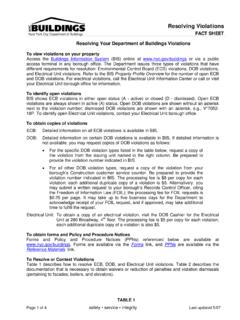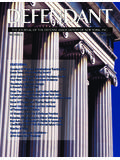Transcription of DEP’s Monitoring for Pathogens New York City’s Water …
1 Does mydrinking watercontainFluoride? Yes, all New YorkCity tap watercontains accordancewith of the NewYork city HealthCode, DEP, as theNew york Citywater supplier,adds a fluoridecompound whichprovides our watersupply with a con-centration ofapproximately per million(ppm) com-menced in MainWaterTunnelWatershedWaterDistributio nMainPumpwaterstorage tank Continuous Monitoring of Water quality flowing into tunnels and aqueducts Water treatment and disinfectionWater Testing andTreatment FacilitiesGravityFedWaterAqueductDistrib ution Reservoir(Hillview/Jerome Park)Source Reservoir(Kensico/New Croton)DividingwallDamWater Sampling Station Nearly 1000 sampling stations throughout New york city Over 35,000 samples are collected and tested annuallyNew york city sWater TreatmentAll surface Water and groundwaterentering New york city s distributionsystem is treated with chlorine, fluo-ride, orthophosphate, and, in somecases, sodium hydroxide.
2 New YorkCity uses chlorine to meet the NewYork State Sanitary Code and federalSafe Drinking Water Act disinfectionrequirements. Fluoride, at a concen-tration of one part per million, is addedto help prevent tooth decay and hasbeen added since 1964 in accordancewith the New york city Health is added to create aprotective film on pipes that reducesthe release of metals, such as lead,from household plumbing. Sodiumhydroxide is added to Catskill/Delawarewater to raise the pH and reduce corro-sivity. A sequestering phosphate is applied atseveral wells to prevent the precipita-tion of naturally occurring minerals,DEP s Monitoring for PathogensIn 1992, the city added a pathogenmonitoring component to its compre-hensive watershed Monitoring pro-gram.
3 Since then, samples have beencollected weekly from the effluents ofKensico and New Croton Reservoirs,before Water is first chlorinated in theCatskill/Delaware and Croton Systems,respectively. In May 1999, DEP imple-mented a more sensitive analyticalmethod which improved theDepartment s ability to detect bothGiardia cysts and Cryptosporidiumoocysts. Current test methods, howev-er, are limited in that they do not allowus to determine if organisms identifiedare dead or if they are capable of caus-ing disease. In 2000, as part of the routine sam-pling program, 105 samples of KensicoReservoir effluent and 52 samples ofNew Croton Reservoir effluent werecollected and analyzed for Giardiacysts and Cryptosporidium oocysts. Ofthe 105 Kensico Reservoir samples, 67samples were presumed positive forGiardia and 10 samples were con-firmed positive.
4 Twelve samples werepresumed positive for Cryptosporidiumat Kensico with no samples confirmedpositive. The New Croton Reservoirsamples produced 24 presumed posi-tive Giardia samples with two samplesconfirmed positive; and, of eight pre-sumed positive Cryptosporidium sam-ples, no samples confirmed updates of DEP s Giardia andCryptosporidium data from 1992 to thepresent can be viewed on our Web iron and manganese, in the dis-tribution mains and customers house-hold piping. Air stripper facilities oper-ate at several wells to remove volatileorganic a Safe andSufficient Supply of Water Watershed ProgramsDuring 2000, New york city continuedimplementation of the watershed pro-tection and partnership programs setforth in the January 1997 WatershedMemorandum of Agreement (MOA).
5 These efforts focused on three key pro-grams: the acquisition of watershedlands; the enforcement of strengthenedWatershed Regulations; and the expan-sion of partnership programs that tar-get specific sources of pollution in thewatershed. In addition, DEP continuedwork on a number of Water qualitystudies, and continued implementingthe upgrades of non- city -owned waste- Water treatment plants (WWTPs). Land AcquisitionIn 2000, DEP met the goals for procur-ing watershed lands set forth in the1997 Filtration AvoidanceDetermination (FAD) and the , DEP solicited 52,846 acresof watershed lands in designated priori-ty areas. As of December 2000, DEPhad 26,970 acres either acquired orunder purchase contract for a cost of$ million. Watershed RegulationsOn May 1, 1997, enhanced WatershedRegulations became effective, replacingregulations that had been in placesince 1953.
6 The Regulations are vitalto Water supply protection and providea higher level of defense against mod-ern-day threats to Water quality. Byvigorously enforcing the newRegulations, DEP is ensuring that theCity s source waters are steps taken to ensure a high quali-ty Water supply include: aggressivepolicing and inspection of the Water -sheds; greatly increased Water qualitymonitoring; systematic inspections ofwastewater treatment plants; investiga-tions of other potentially pollutingactivities; and legal actions against pol-luters. Furthermore, in 2000, DEP staffreviewed more than 1,719 applicationsfor new or remediated septic systems,125 stormwater pollution preventionplans, and more than 200 proposals forother projects that included one ormore regulated activities.
7 Partnership ProgramsWest of the Hudson River, many of thepartnership programs are being admin-istered by the Catskill WatershedCorporation (CWC), a non-profit cor-poration formed solely for that pur-pose. Together, CWC and DEP contin-ued to implement programs that reme-diated 193 failing septic systems, com-pleted construction of 29 winter roadde-icing materials storage facilities, andidentified a second group of best man-agement practices to address existingstormwater runoff. The Watershed Agricultural Program,funded by DEP and implemented bythe Watershed Agricultural Council hasbecome a national model. More than90% of watershed farms have joined theprogram, which develops BestManagement Practices to reduce agri-cultural pollution and enhance the eco-nomic viability of participating aerators inmy home areclogging withsmall pieces ofa whitish mate-rial.
8 What iscausing this tooccur? This is a frequent com-plaint from problem may beaccompanied by a sig-nificant drop in waterpressure at the affect-ed faucet in additionto a decrease in yourhot Water supply. Theculprit is the hot waterheater s dip-tube .This is a long internaltube which deliverscold Water to the bot-tom of the hot waterheater tank. Thetube, which is com-posed of polypropy-lene, may problem affectsapproximately 16 mil-lion Water heatersmanufactured between1993 and Program includes a watershedforestry component and theConservation Reserve EnhancementProgram (CREP). Under CREP, the USDepartment of Agriculture paysenhanced annual rental rates and otherincentives to agricultural landowners totake environmentally sensitive landsout of production.
9 The city and USDA each pay half the cost of treating thoselands with conservation practices. Todate, more than fifty landowners haveenrolled over 600 acres of riparianbuffer lands into Treatment Plant UpgradesThe city continues to advance the pro-gram to upgrade all of the 102 non- city -owned wastewater treatmentplants (WWTP) in the watershed. Allfacilities have signed agreements toparticipate in the upgrade program andhave hired engineers to completeupgrade designs. Construction isexpected to begin on the first of theseupgrades in 2001. The city hadupgraded its own watershed WWTPs inthe late Capital ImprovementsThe city continued to implement amulti-year program to upgrade andimprove its upstate Water supply facili-ties, including gatehouses, aqueducts, Water testing laboratories, and otherfacilities which are important to ensur-ing a safe and reliable supply of drink-ing Water .
10 An ongoing dam reconstruc-tion program has also been in effect forrehabilitation of dams. In 2000, workwas done on facilities at five reservoirsand three controlled lakes. In addition,work is expected to begin on five morereservoirs in 2001. Highlights of thisyear s work include the replacement ofroller and sluice gates as well as thechlorination systems in Shaft 18 andthe Catskill Screen Chamber, andrepairs to the gate valve in Shaft 6 ofthe Delaware Aqueduct completed inthe first week of Distribution System city Water Tunnel No. 3 The Third Water Tunnel, begun in1970, is being built in stages. The firststage of Tunnel No. 3, which becameoperational in July 1998, has alreadyhelped to improve the reliability of theCity s drinking Water distribution sys-tem.














